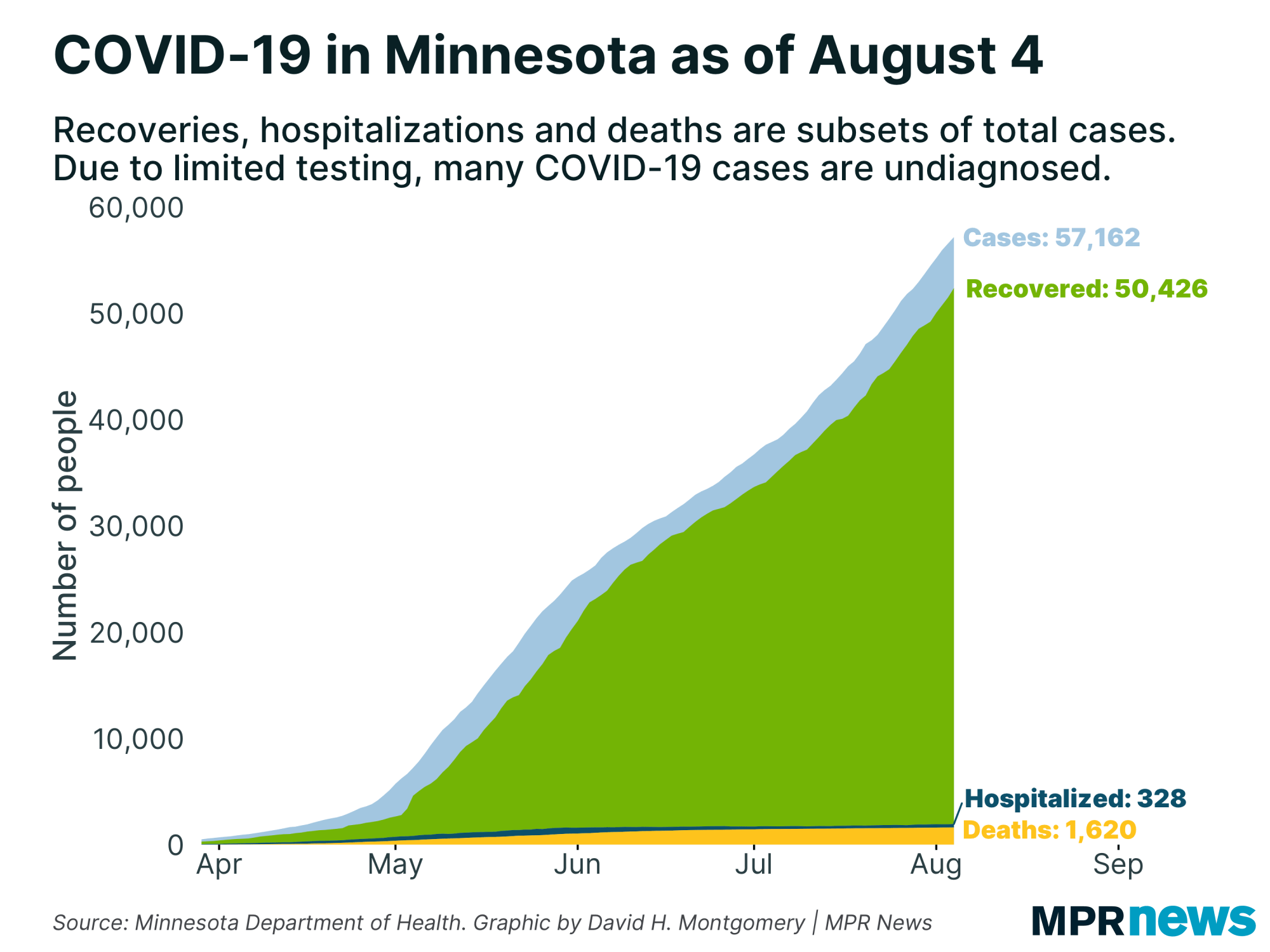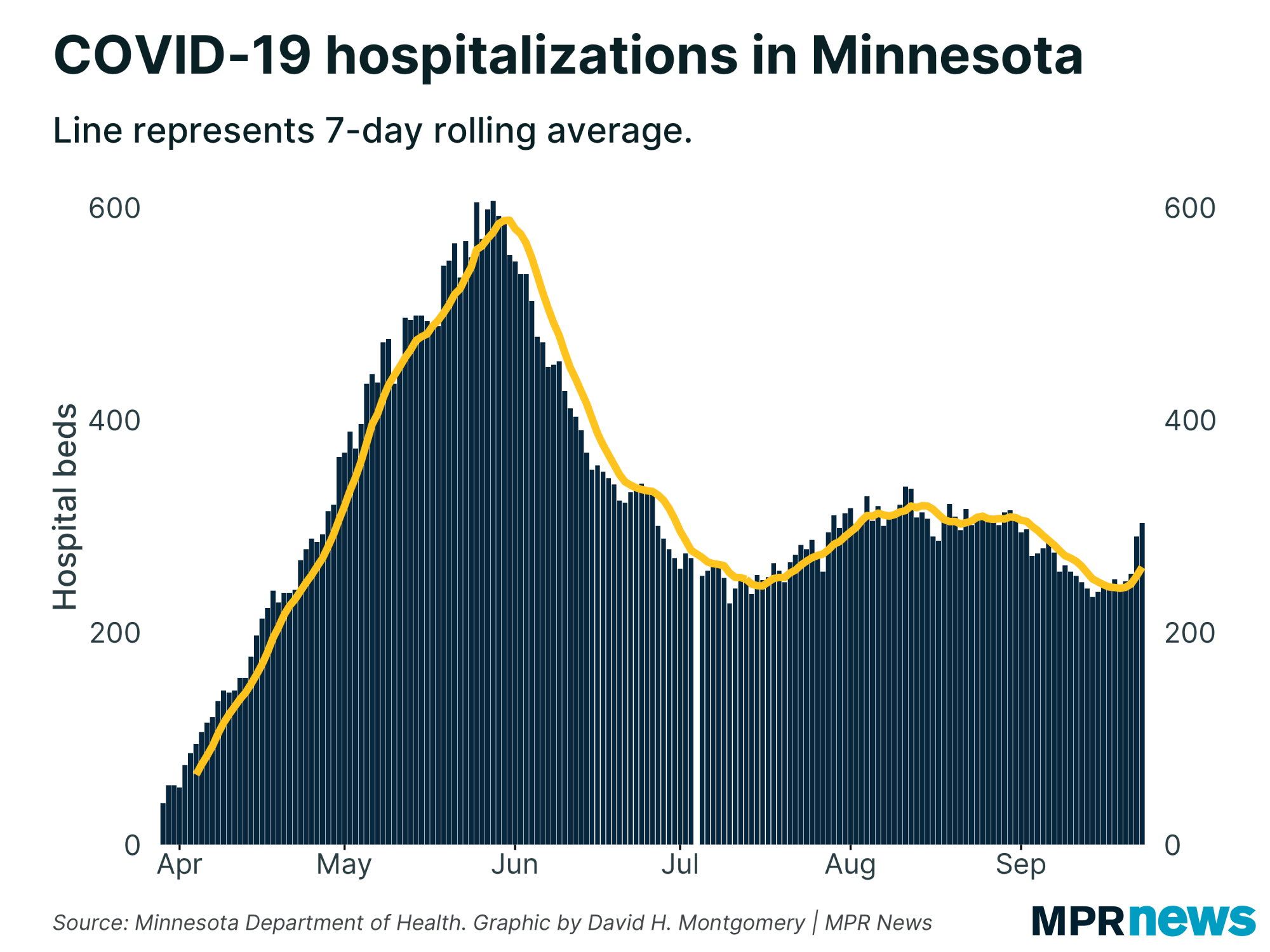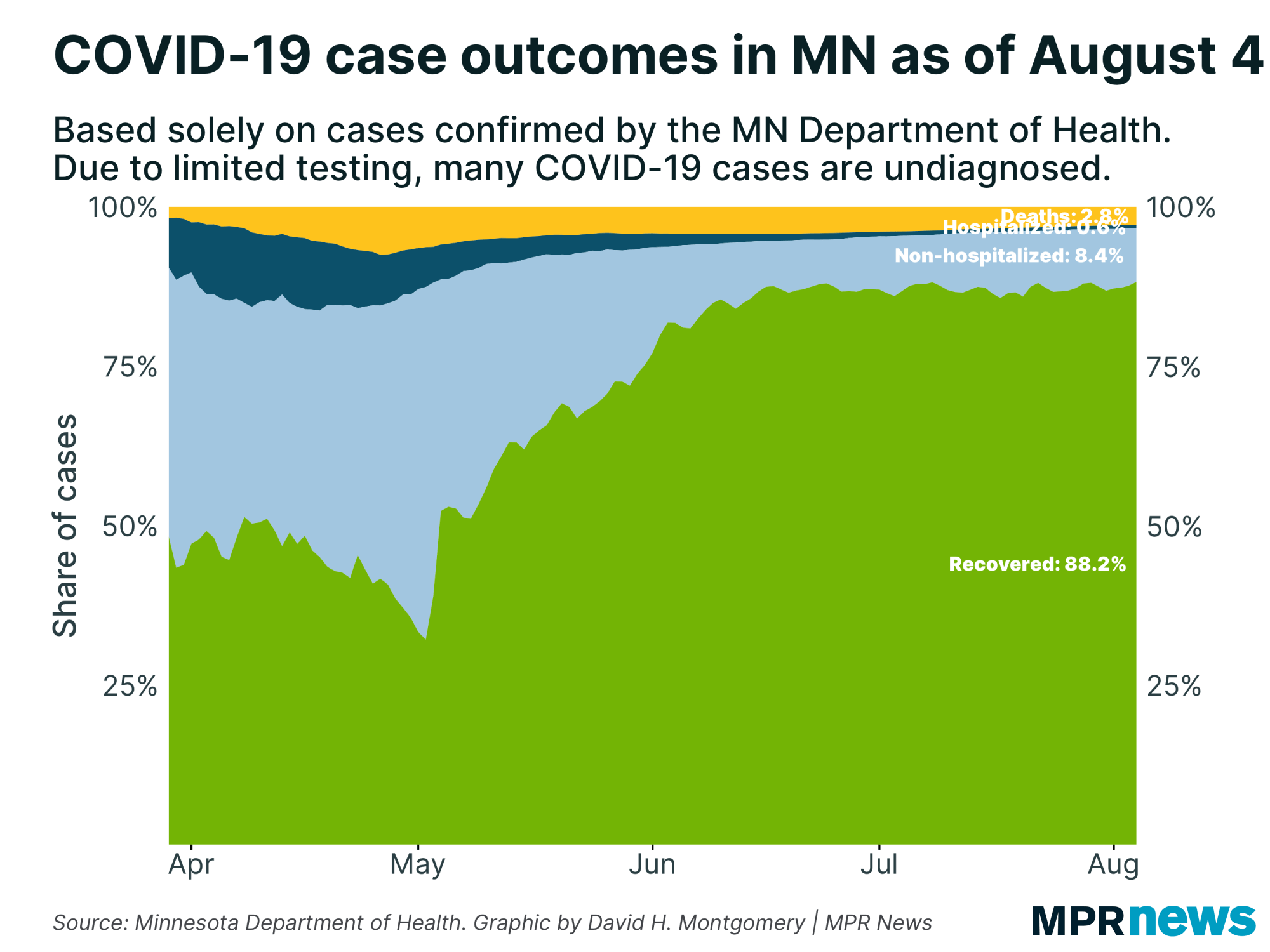June 25 update on COVID-19 in MN: 1,406 deaths; hospitalizations, ICU cases flat

Go Deeper.
Create an account or log in to save stories.
Like this?
Thanks for liking this story! We have added it to a list of your favorite stories.
Updated 7:55 p.m.
Minnesota passed another grim milestone in the COVID-19 pandemic as health officials reported more than 1,400 people have died from the disease.
Trends, though, continue to show a slowing death rate. Thursday marked the first time since mid-April that the state reported five consecutive days of deaths in the single digits.
The counts of people currently hospitalized (336) and needing intensive care (162) — two closely watched metrics as officials try to manage the spread of the disease — continue to flatten, with an overall downward trend the past few weeks.
Of the 34,123 confirmed cases of COVID-19 since the outbreak began, state officials say about 88 percent of those infected have recovered to the point they no longer need to be isolated.
Turn Up Your Support
MPR News helps you turn down the noise and build shared understanding. Turn up your support for this public resource and keep trusted journalism accessible to all.
Among those who’ve died, nearly 80 percent were living in long-term care or assisted living facilities; nearly all had underlying health problems.
Bar-driven cluster surfaces in Blue Earth County
The newest counts come a day after officials expressed concerns that many people — especially young adults — aren’t doing enough to help minimize the spread of COVID-19 as they return to social spaces.
Through contact tracing, some 100 cases of COVID-19 were reported in Minnesotans in their 20s who said they went to bars in the south-central part of the state on June 12 and 13 — the first weekend bars and restaurants were allowed to serve indoors.
The state Health Department didn’t say exactly where, or which bars, drove the cluster. On Thursday morning, however, officials in Blue Earth County, which includes Mankato, acknowledged a surge of 91 cases since June 20 with nearly all those sickened in the 19- to 25-year-old age range.
While those young people may be less likely to suffer complications from COVID-19, officials say the concern is that they may be inadvertently spreading the disease to grandparents or other potentially vulnerable populations.

State infectious disease director Kris Ehresmann said some of the people who tested positive work in child care and health care, pointing out that they have a high likelihood of spreading the disease in their workplace.
She said that this situation underscores the risk the state took when deciding to allow bars and restaurants to reopen.
“We want to make sure that even as we’re happily taking advantage of the opening of bars and restaurants that people, even if you’re young and you feel your personal risk of COVID is low, you’re continuing to social distance and wear masks,” Ehresmann said.
Mankato Chamber of Commerce President Jessica Beyer said that like a lot of business associations, they have been offering local businesses advice and education on how to keep their employees and customers protected, such as encouraging mask-wearing and keeping tables 6 feet apart.
Meanwhile, state officials said Wednesday that restaurants and bars don’t have to report positive COVID-19 cases to the state or the public if an employee or customer tests positive for the disease.

Racial disparities
State officials have been encouraging people who participated in protests following the killing of George Floyd to get tested for COVID-19. The Health Department has offered free testing in Minneapolis and St. Paul the past two weeks.
While officials have been encouraged that positive cases are running less than 2 percent — suggesting that a rapid spread of the disease stemming from the protests is not happening in a way officials had feared — the testing has revealed some stark racial disparities.
Ehresmann said results of two weeks of that testing showed wide differences in the rates of positive results for COVID-19. She said the positive rate for whites was 0.2 percent, but it was 1.3 percent for Blacks, 7.4 percent for Latino populations and 5 percent for people of Asian heritage.
People of color made up 40 percent of those tested, but 90 percent of the positives.
Ehresmann said the data reinforces her agency’s concern over racial disparities "due to differences in rates of underlying health conditions and job exposure risk."
Meatpacking hot spots remain
Many of the outbreaks outside the Twin Cities metro area are focused around meatpacking plants. Officials have intensified testing in those hot spots, uncovering more infections.
That includes Mower County in southeastern Minnesota, where there were 847 confirmed cases as of Thursday.
Mower County is home to Hormel Foods and Quality Pork Processors. Both have been partnering with Mayo Clinic to ramp up employee testing.

While some of Mower County’s positive cases are associated with people who work in the facilities and with the people they live with, county officials say they are also seeing transmission among people who live in the county but work in other counties where coronavirus is present.
Health officials held a COVID-19 testing push in Austin, Minn., over the weekend.
Nobles, in southwestern Minnesota, reported 1,637 confirmed cases Thursday. About 1 in 14 people now have tested positive for COVID-19 in the county, although there have only been a few additional cases recorded the past few days.
Worthington’s massive JBS pork processing plant was the epicenter of the Nobles outbreak. The JBS plant shut on April 20 but has since reopened with expanded hygiene and health monitoring measures.
Similar problems have been reported in Stearns County, where COVID-19 cases tied to two packing plants — Pilgrim’s Pride poultry plant in Cold Spring and Jennie-O Turkey in Melrose — skyrocketed in May.
An undisclosed number of workers at both plants have tested positive for the virus. There were about 55 confirmed cases in Stearns County in early May. By Thursday, confirmed cases were at 2,141 with 19 deaths.
Kandiyohi County in west-central Minnesota is also seeing cases continue to climb more than a month after officials with the Jennie-O turkey processing plant there said some employees had tested positive for the coronavirus. The county had confirmed three COVID-19 cases then.
As of Thursday, the Health Department reported 564 people have now tested positive in the county.
Cases have also climbed noticeably in Cottonwood County (127 cases), home to a pork processing plant in Windom, and in Lyon County (284 cases), around a turkey processor in Marshall.
Developments from around the state
Inmate dies at Faribault prison after testing positive for COVID-19
The Minnesota Department of Corrections on Thursday reported a 43-year-old inmate at the Faribault prison has died nearly three weeks after testing positive for the coronavirus.
In a statement, the department says Adrian Raymaar Keys died at a hospital Tuesday evening. Keys and an unspecified number of other men tested positive for COVID-19 on June 4.
The agency says Keys' health deteriorated over the weekend and he was hospitalized on Monday. If the Hennepin County Medical Examiner determines that his death was related to COVID-19 complications, it would be the first COVID-19-related death of a Minnesota inmate.
More than 200 Faribault inmates — or about 12 percent of the prison's population — have tested positive for the coronavirus in June. That's far more than in any other Minnesota prison.
The Corrections Department says four Faribault staff members also tested positive, but have since returned to work.
— Matt Sepic | MPR News
Mayo Clinic to end pay cuts, recall workers
Mayo Clinic says it is reversing pay cuts and ending worker furloughs initially put in place due to the COVID-19 pandemic.
The clinic says outpatient visits, medical procedures and surgeries are picking up, so it will be restoring pay levels for thousands of employees as of Wednesday and bringing back idled workers by the end of August, ahead of their scheduled return.
The pay cuts were announced in April as Mayo was projecting a $900 million loss through the end of 2020 after Gov. Tim Walz announced a ban on nonessential medical procedures to preserve masks and other medical supplies for an expected surge in COVID-19 cases.
Physicians and senior administrators were given a 10 percent salary cut, with a 7 percent cut for other salaried employees. Senior executives took a 20 percent pay cut, and that reduction is not being rolled back.
Mayo says patient volumes had returned to as much as 90 percent of normal by mid-June.
— Tim Nelson | MPR News
Twins have had ‘a few’ recent positive tests
The Minnesota Twins have become the latest Major League Baseball team to report cases of coronavirus within its organization.
President of baseball operations Derek Falvey said in a conference call Thursday that “a few" players had tested positive and that each player was “doing well” in self-isolation at home. None of the positive tests came from players currently in Minnesota or in Fort Myers, Fla., where the team’s spring training headquarters are.
While he didn't identify them or specify the number, Falvey said that all were members of the 60-man group that is scheduled to begin workouts next week ahead of a planned regular season. Before they can join the team in Minneapolis, each player must return two negative coronavirus tests. Major league camps are set to reopen next week, mostly at home stadiums.
Prior to the recent positive tests, Falvey said, the Twins had no known cases among players or staff.
— MPR News staff and The Associated Press
Masks to be required at St. Cloud State University this fall
St. Cloud State University will require masks to be worn in its campus buildings this fall.
The university announced this week it will require face coverings for all students, faculty and staff in its buildings at least for fall semester beginning Aug. 24. St. Cloud State will offer a mix of in-person and online classes this fall.
Jennifer Super, director of the school’s emergency preparedness and transportation services, said the decision should provide some clarity and comfort for people returning to campus this fall.
"I think it provided answers for people that were asking — ‘Are we going to make [masks] mandatory?’” Super said. "It sets the tone for the fall that our students and employees' safety is No. 1.”
Super said details are still being worked out, but the policy likely will apply to buildings, classrooms, shared office spaces and outdoor areas where it's difficult to practice social distancing.
St. Cloud State's approach differs from the University of Minnesota, which is strongly recommending but not requiring masks.
— Kirsti Marohn | MPR News
Top headlines
Four ways COVID-19 has hit different parts of Minnesota: The COVID-19 pandemic has touched all but one of Minnesota’s 87 counties — but it hasn’t hit all parts of the state equally. Here’s a breakdown of the cumulative cases per capita in each of Minnesota’s major regions.
MSP airport stepping up safety measures, encouraging passengers to wear masks: The "Travel Confidently” plan includes a variety of new sanitation measures and messaging to encourage social distancing and mask-wearing at the Twin Cities airport.
St. Paul council leans toward approving tenant protections this summer: With financial pressure from the COVID-19 pandemic mounting for many Minnesota families, the St. Paul City Council is considering new tenant protections.
COVID-19 in Minnesota
Data in these graphs are based off Minnesota Department of Health cumulative totals released at 11 a.m. daily. You can find more detailed statistics on COVID-19 at the Health Department website.
The coronavirus is transmitted through respiratory droplets, coughs and sneezes, similar to the way the flu can spread.
Government and medical leaders are urging people to wash their hands frequently and well, refrain from touching their faces, cover their coughs, disinfect surfaces and avoid large crowds, all in an effort to curb the virus’ rapid spread.


